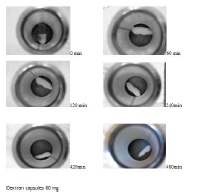Design and evaluation of oral delivery formulations based on dextran with theophylline.
Keywords:
Dextran, theophylline, tablets, capsules, sustained release, releaseAbstract
The purpose of this investigation was to develop and evaluate different oral drug release delivery formulations namely, tablets and capsules, based on dextran, in order to determine how the quantity of dextran and the form-structure of the delivery systems influence drug release and release mechanisms. Theophylline was used as the model drug. All matrix tablets and one capsule formulation demonstrated sustained release profiles. The amount of dextran and its properties (particularly erosion) along with the form of the preparation were found to considerably affect the performance of the system, the release profiles and the mechanism of release. In all cases an increase in the quantity of dextran resulted in a decrease in the release rate indicating that acted as a kind of barrier and hindered the release of drug molecules from these formulations. Significant differences were also observed among the different preparations under examination, with the matrix tablets exhibiting the slowest drug release followed by the capsules. By altering the dextran/theophylline ratio or the form of the preparation it is possible to obtain appropriate drug release. Consequently dextran appears to be a versatile material and a promising vehicle for the preparation of various oral sustained release drug delivery systems and relevant devices.
References
. Rubinstein A. Microbially controlled drug delivery to the colon. Biopharm Drug Disp. 1990;11:465-75.
. Castellanos Gil E, Colarte A, Bataille B, Pedraz J, Rodriguez F, Heinamaki J. Development and optimization of a novel sustained release dextran tablet formulation for propranolol hydrochloride. Int J Pharm. 2006;317:32-9.
. Castellanos Gil E, Colarte A, El Ghzaoui A, Durand, Delanbre J, Bataille B.A sugar native dextran as an innovative functional excipient for the development of pharmaceutical tablets. Eur J Pharm Biopharm. 2008;68:319-29.
. Castellanos Gil E, Colarte A, Bataille B, Caraballo I. Estimation of the percolation threshold in lobenzarit disodium native dextran matrix tablets. AAPS PharmSciTech. 2007;8(4):289-97.
. Chourasia M, Jain S. Polysaccharides for colon targeted drug delivery. Drug Del. 2004;11:129-48.
. Simonsen L, Hovgaard L, Mortensen P, Brondsted H. Dextran hdrogels for colon specific drug delivery. Eur J Pharm Sci. 1995;3:329-37.
. Chidambram N, Porter W, Flood K, Qiu Y. Formulation and characterization of new layered diffusional matrices for zero-order sustained release. J Contr Rel. 1998;52:149-58.
. Efentakis M, Vlachou M, Choulis N. Effects of excipients on swelling and drug release from compressed matrices. Drug Dev Ind Pharm. 1997;23:107-112.
. Danckwerts M. Optimization and Development of a Core-in-Cup tablet for modulated release of theophylline in simulated gastrointestinal fluids. Drug Dev Ind Pharm. 2000;7:767-72.
. Efentakis M, Iliopoyloy A, Siamidi A. Effect of core size and excipients on the lag time and drug release from a pulsatile drug delivery system. Drug Dev Ind Pharm. 2010;37:113-20.
. Efentakis M, Peponaki C. Formulation and evaluation of matrix and three-layer tablet sustained drug delivery systems based on cabopols with isosorbite mononitrate. AAPS PharmSciTech. 2008;9:917-23.
. Yang L, Fassihi R. Accesibilty of solid core tablet for dissolution in a asymmetric triple-layer matrix system. J Pharm Pharmc. 2003;55:1331-37.
. Efentakis, M, Pagoni I, Vlachou M, Avgoustakis K. Dimensional changes, gel layer evolution and drug release studies in hydrophilic matrices loaded with drugs of different solubility. Int J Pharm. 2006;311:147-156.
. Khan K. The concept of dissolution efficiency. J Pharm Pharmac. 1975;27: 48-9.
. Zhang Y, Chu C. Thermal and mechanical properties of biodegradable hydpophilic hydriogels based on dextran and poly(lactic acid). J Mater Sci. Materials in Medicine. 2002;13:773-781.
. Papadimitriou E, Buckton G, Efentakis M. Probing the mechanisms of swelling of hydroxypropylmethylcellulose matrices. Int J Pharm. 1993 ;98:57-62.
. Efentakis M, Pagoni I, Vlachou M, Avgoustakis K. Dimensional changes, gel layer evolution and drug release studies in hydrophilic matrices loaded with drugs of different solubility. Int J Pharm. 2007;339:66-75.
. Gao P, Meury H. Swelling of hydroxypropylmethylcellulose matrix Tablets. Characterization of swelling using a novel optical imaging method. J Pharm Sci. 1996;85:725-31.
. Efentakis M, Vlachou M. Evaluation of high molecular Poly(oxyethylene) polymer: Studies of flow properties and release rates of furosemide and captopril from controlled release hard gelatin capsules. Pharm Dev Technology. 2000;5:339-46.
. Korsmeyer R, Gurny R, Doelker E, Buri P, Peppas N. Mechanisms of solute release from porous hydrophilic polymers. Int J Pharm. 1983;15:25-35.
. Chen G, Hao W. Factors affecting zero order release kinetics of porous gelatine capsules. Drug Dev Ind Pharm. 1998;24:557-62.






